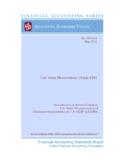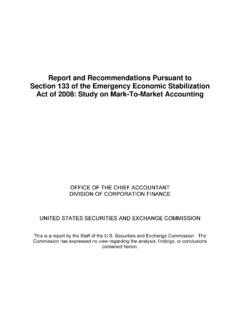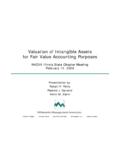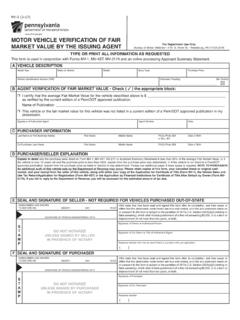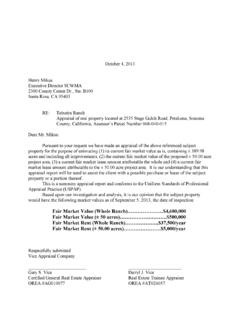Transcription of Rev. Proc. 90-12, 1990-1 C.B. 471 SECTION 1. …
1 Rev. Proc. 90-12, 1990-1 471 SECTION 1. PURPOSE These guidelines are intended to provide charitable organizations with help in advising their patrons of the deductible amount of contributions under SECTION 170 of the Code when the contributors are receiving something in return for their contributions. These guidelines will also be used by agents in determining whether charities have provided accurate information about deductibility to their contributors. SECTION 2. BACKGROUND 01 Recently, the Congress expressed concern that charities do not accurately inform their patrons of the extent to which contributions are deductible. In expressing its concern, the Congress stated that it 'anticipates that the Internal Revenue Service will monitor the extent to which taxpayers are being furnished accurate and sufficient information by charitable organizations as to the nondeductibility of payments to such organizations where benefits or privileges are received in return, so that taxpayers can correctly compute their Federal income tax liability.
2 ' Rep. No. 100-391, 100th Cong., 1st Sess. 1608 (1987). 02 In August 1988, the Service sent Publication 1391, Deductibility of Payments Made to Charities Conducting Fund-Raising Events, to over 400,000 charities. Publication 1391 contains a message from the Commissioner of the Internal Revenue Service asking charities for help in informing contributors more accurately about the deductibility of contributions made in connection with fund-raising events and programs. 03 Publication 1391 also contains a copy of Rev. Rul. 67-246, 1967-2 104, which discusses the rules that apply in determining the amount of a charitable contribution under SECTION 170 of the Code when something of value is received in return for the contribution.
3 Rev. Rul. 67-246 also sets forth a simple procedure that charities can use to provide 'accurate and sufficient' information to their contributors. 04 Rev. Rul. 67-246 asks charities to determine the fair market value of the benefits offered for contributions in advance of a solicitation and to state in the solicitation and in tickets, receipts, or other documents issued in connection with a contribution how much is deductible under SECTION 170 of the Code and how much is not. If charities are unable to make an exact determination of the fair market value of the benefits, Rev. Rul. 67-246 indicates that they should use a reasonable estimate of fair market value . 05 Many charities have suggested that this determination is difficult or burdensome particularly in the case of small items or other benefits that are of token value in relation to the amount contributed.
4 The Service has determined that a benefit may be so inconsequential or insubstantial that the full amount of a contribution is deductible under SECTION 170 of the Code. Under the following guidelines, charities offering certain small items or other benefits of token value may treat the benefits as having insubstantial value so that they may advise contributors that contributions are fully deductible under SECTION 170. SECTION 3. GUIDELINES 01 Benefits received in connection with a payment to a charity will be considered to have insubstantial fair market value for purposes of advising patrons if the requirements of paragraphs 1 and 2 are met: 1. The payment occurs in the context of a fund-raising campaign in which the charity informs patrons how much of their payment is a deductible contribution, and either 2.
5 (a) The fair market value of all of the benefits received in connection with the payment, is not more than 2 percent of the payment, or $50, whichever is less, or (b) The payment is $25 (adjusted for inflation as described below) or more and the only benefits received in connection with the payment are token items (bookmarks, calendars, key chains, mugs, posters, tee shirts, etc.) bearing the organization's name or logo. The cost (as opposed to fair market value ) of all of the benefits received by a donor must, in the aggregate, be within the limits established for 'low cost articles' under SECTION 513(h)(2) of the Code. (Generally, under SECTION 170, the deductible amount of a contribution is determined by taking into account the fair market value , not the cost to the charity, of any benefits received in return.)
6 For administrative reasons, however, in the limited circumstances of this subparagraph, the cost to the charity may be used in determining whether the benefits are insubstantial.) 02 For purposes of paragraph 1 of SECTION , above, a qualifying fund-raising campaign is one designed to raise tax-deductible contributions, in which the charity determines the fair market value of the benefits offered in return for contributions (using a reasonable estimate if an exact determination is not possible), and states in its solicitations (whether written, broadcast, telephoned, or in person) - as well as in tickets, receipts, or other documents issued in connection with contributions - how much is deductible under SECTION 170 of the Code and how much is not.
7 If a charity is providing only insubstantial benefits in return for a payment, fund-raising materials should include a statement to the effect that: 'Under Internal Revenue Service guidelines the estimated value of benefits received is not substantial; therefore the full amount of your payment is a deductible contribution.' 03 There may be situations in which it is impractical to state in every solicitation how much of a payment is deductible. For example, where a nonprofit broadcasting organization offers a number of premiums in an on-air fund-raising announcement, it may be unduly cumbersome to include information on the fair market value of each premium. If a charity believes that stating how much is deductible in every statement is impractical, it may seek a ruling from the Service concerning an alternative procedure.
8 The Service will rule on whether the alternative procedure meets the Congressionally mandated goal of providing accurate and sufficient information to contributors. See Rev. Proc. 90-4, 1990-2 15. 04 For purposes of paragraph 2 of SECTION , above, newsletters or program guides (other than commercial quality publications) will be treated as if they do not have a measurable fair market value or cost if their primary purpose is to inform members about the activities of an organization and if they are not available to nonmembers by paid subscription or through newsstand sales. Whether a publication is considered a commercial quality publication depends upon all of the facts and circumstances. Generally, publications that contain articles written for compensation and that accept advertising will be treated as commercial quality publications having measurable fair market value or cost.
9 Professional journals (whether or not articles are written for compensation and advertising is accepted) will normally be treated as commercial quality publications. For purposes of subparagraph (b) of paragraph 2, the cost of a commercial quality publication includes the costs of production and distribution and must be computed without regard to income from advertising or newsstand or subscription sales. 05 In applying paragraph 2, the total amount of a pledge payable in installments will be considered to be the amount of the payment. Also, benefits provided by charities in the form of cash or its equivalent will never be considered insubstantial. 06 For purposes subparagraph (b) of paragraph 2, an item is a 'low cost article' under SECTION 513(h)(2) of the Code if its cost does not exceed $5, increased for years after 1987 by a cost-of-living adjustment under SECTION 1(f)(3) The $25 payment required in subparagraph (b) of paragraph 2 must also be increased, in the same manner.
10 For calendar year 1990, the cost of a 'low cost article' under SECTION 513(h)(2) cannot exceed $ The adjusted required payment is $ See Rev. Proc. 90-7, 1990-3 , 8. 07 For purposes of subparagraph (b) of paragraph 2, if items offered to contributors are donated to the charity or if services are donated in connection with the production of an item, the cost 'to the organization' for purposes of SECTION 513(h)(2) of the Code will be a reasonable estimate of the amount the organization would have to pay for the items or services in question. 08 These guidelines describe a safe harbor; depending on the facts in each case, benefits received in connection with contributions may be 'insubstantial' even if they do not meet these guidelines.










